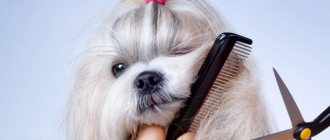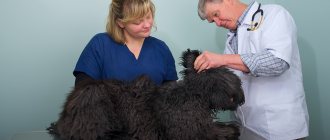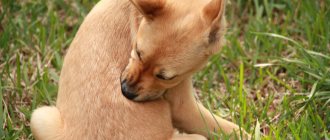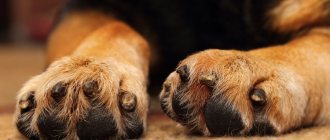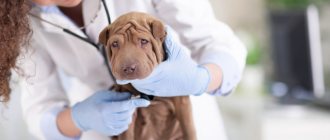Grooming is an essential part of caring for a dog; depending on the breed, this can include cutting, trimming, plucking, and untangling tangles. Almost every four-legged pet regularly goes through similar procedures. Sometimes after their completion, redness and peeling remain, and the animal begins to actively itch.
Many owners, seeing such consequences of procedures, blame incompetent craftsmen, unsanitary conditions or incorrect, insufficiently high-quality tools for redness on the skin of their pets, but often the cause of such reactions is not only the unskillful hands of the master, but also a whole list of other reasons that need to be eliminated.
Reasons why a dog may shake its ears
- The dog shakes its ears after sleep . This is an absolutely normal physiological phenomenon. During sleep, sulfur can accumulate in the ear canals, and after sleep, the animal, trying to get rid of it, begins to shake its head, in particular its ears. There is no need to fight this.
- Otitis . Owners rarely pay attention to their pet's ears, but dogs very often have problems with them. For example, various types of otitis media. Fungal, bacterial, allergic. In this case, wax may accumulate in the ears, and subsequently pus, and they will smell unpleasant. And the discharge will be visible to the naked eye.
- Allergic reactions . Food allergies, although an extremely rare phenomenon in dogs, do occur. Almost all food allergies in animals are cumulative.
- Ear mite . Ear mites can be seen with the naked eye. This is a dark brown discharge, of which there is a huge variety. If you look at these secretions under a microscope, they will be the “cutest” mites.
- Injuries . Various blows and bruises also cause discomfort in dogs. This causes animals to shake their ears from time to time. Fold-eared dogs are especially susceptible to various injuries. Therefore, it is recommended to examine your pet's ears daily.
- External stimuli . These include grooming, trimming, haircuts, water and foreign objects.
Treatment
Parasitoses
The use of insecticidal preparations aimed at destroying the pathogen.
Allergies
Prescription of antihistamines, for food allergies - a therapeutic diet using hypoallergenic feed.
Effect of high and low temperatures
For skin damage, antibiotic therapy, glucocorticosteroids and local treatments are prescribed.
Fungal and bacterial infections
Antifungal drugs and antibiotic therapy are prescribed.
Stress
Prescribing sedatives.
The dog shakes its ears after a haircut: Let's understand the terms
First, it’s worth understanding the difference between such terms as grooming, trimming and haircuts. Most owners believe that they clearly know the concept of “haircut”. But they don’t even have an idea about the difference between a hygienic haircut and a model haircut.
Grooming
This is, first of all, the behavior of the animals themselves. It is associated with cleansing one's skins. Since our pets are tamed and domesticated animals, grooming depends on the owners themselves.
It is a mistake to believe that grooming is only a haircut and not all dogs require it. This also includes trimming nails, cleaning ears, anal glands, eyes, and folds on the face of such breeds as Pekingese, pugs, and bulldogs.
Watch the video: How to properly clean a dog's ears - The vet shows on the ear canal
Trimming
This is the manual or mechanical removal of hair that has already died off, but due to certain characteristics of the breed, cannot fall out on its own. Trimming does not bring any unpleasant sensations to the dog.
Breeds that require systematic trimming are various terriers, schnauzers and other wire-haired dog breeds whose coat, in the process of evolution, has lost the ability to shed independently. Essentially, trimming is plucking fur (buy, for example, such a trimmer).
In their natural environment, wire-haired dogs, which were mostly hunting dogs, pulled out dead hair on dry grass, thorny plants, and tree bark. Now, in apartment conditions, this function is performed either by groomers or by the owners themselves.
Watch the video: Grooming and trimming - Demonstration
A haircut
It seems that everything is clear here. Grooming is done by those who are too lazy to take good care of their dogs in a timely manner. But no, in addition to such haircuts, there are hygienic ones.
Many dog breeds require timely trimming of facial hair that interferes with looking, breathing, and eating. For example, a breed that seems to absolutely not need a haircut is the Pekingese.
Very few people know that Pekingese dogs need to promptly trim the fur between their toes, which interferes with walking. In addition to the Pekingese, there is a breed called the Yorkshire Terrier, whose coat grows constantly and requires regular haircuts.
If preparation for a haircut and care after it is not carried out correctly, dogs may become irritated. It is caused by small hairs that are cut during the process but not removed afterwards. To stop the dog’s obsessive behavior, you just need to lubricate the ears with oil or Vaseline . The prickly hairs will stop sticking into the skin and will no longer cause pain.
Skin diseases
Owners often do not understand what to do if the dog is itchy all the time, but it does not have fleas or other parasites. The fact is that parasitosis is only one of the possible causes. The symptom may also occur due to allergies, exposure to high or low temperatures, fungal or bacterial infections, or malfunction of the exocrine glands.
Allergy
Increased sensitivity to certain irritants causes the dog to experience itching, peeling of the paw pads and redness of the interdigital area. Watery discharge appears from the eyes and nose, and swelling and rash appear on the skin. Diarrhea and excessive sweating may occur, which can be easily detected by a damp sleeping area.
Allergic reactions in four-legged pets are more severe than in humans. They get worse with age, so it is recommended to stop attacks immediately after they occur.
Irritation from cold or heat
Overheating and frostbite injure the skin, so the animal constantly licks itself. This leads to the development of acral dermatitis - compulsive licking, leading to the formation of dense ulcerations and tissue death. This disease causes severe intoxication and is difficult to treat. Heat can also cause itchy pyoderma and even cancer.
Fungus (lichen)
The most dangerous fungal infection is ringworm. It is caused by fungi of the genus Microsporum. A sick dog constantly scratches its hind legs, neck and head. As the disease progresses, the fungi spread to the back and eventually affect the entire body. Infected skin develops circular redness, dry scabs and bald areas with well-defined borders.
Bacterial infection
Skin diseases are often caused by bacterial infections. The most common causes of pathology are streptococci and staphylococci, which cause pyoderma. This disease is accompanied by the appearance of erosive and ulcerative formations, purulent papules and skin inflammation. The patient's body becomes covered with dandruff and begins to emit a pungent smell of rot. The dog itches and bites the itchy areas, becoming weak and lethargic.
The hips, anus and base of the tail are primarily affected. The affected areas become covered with a rash, and their temperature rises. When touching the inflamed areas, the pet experiences a feeling of pain. Without treatment, inflammation spreads to neighboring areas, which can lead to necrosis and sepsis.
Hyperfunction of the sebaceous glands
Hyperplasia of the sebaceous glands, or sebaceous tail, occurs due to a disruption of the secretory function. The exact cause of this pathology has not been identified, but veterinarians identify several predisposing factors:
- lack of regular skin and coat care;
- the presence of other skin diseases or allergies;
- being kept in poor conditions and having a poor diet;
- sudden decrease in immunity.
Itchy sensations appear near the anus and at the base of the tail. Blackheads, redness, lumps and dandruff appear in these places. The fur begins to stick together and fall out.
After trimming, the dog itches and shakes its ears
Wire-haired dog breeds that undergo trimming may also experience discomfort after the procedure, especially if it is performed by a novice or non-professional groomer.
There are three types of trimming:
- exhibition ; This type of trimming allows you to show all the anatomical features of the dog in the best possible way at exhibitions.
- hygienic ; This is a mandatory type of trimming necessary for the animal to live a full life.
- cosmetic ; it helps keep six dogs neat.
The hair on the ears is most often removed with a special stone knife.
Fight itching
As mentioned above, allergy treatment begins with determining its cause. Unfortunately, the search may take a long time, and the animal will be forced to experience discomfort for a long time due to unpleasant symptoms.
The biggest concern is allergic itching. The innovative drug Apoquel can help relieve this symptom. It contains the active substance oclacitinib. At the cellular level, it limits the functioning of the receptor that responds to the allergen and causes itching.
According to individual indications, the animal may be prescribed hormonal drugs (corticosteroids) and immunosuppressants (cyclosporine). However, the use of these drugs can cause side effects: drowsiness, disorders of the gastrointestinal tract, behavior changes, thirst, frequent urination, increased appetite.
Remember, only a veterinarian can prescribe treatment. Do not use medications without consulting a specialist!
How to help an animal in such a situation?
- After trimming, use any base cosmetic oil . Apricot, almond, grape, pumpkin, olive. You need to moisten a cotton wool with oil and lightly wipe the inside of the ear along the growth of the fur. This will soften the skin and relieve irritation.
- Use aftershave lotion after trimming . An ordinary human lotion will also disinfect the skin, relieve inflammation and dry out the micro-wounds that appear after the trimming procedure.
In addition, after trimming, you can use baby cream , Bepanten , or any other product that relieves redness and irritation.
Survey
The first thing the veterinarian does during a proper examination is to clarify the history of treatment for worms and carefully check for the presence of fleas. Diagnosing worms can be a little tricky upon examination unless the infestation is severe and there are no adult worms or tapeworm segments visible in the feces or lodged in the fur around the anus. If a specialist has determined that worms are the problem causing the symptoms, the dog is simply treated with a high-quality product in the correct dosage.
Your dog's ears are itchy: How to treat it at home
First you need to contact a veterinarian, ideally a veterinary dermatologist , to make a correct diagnosis. Before visiting a doctor, it is strongly recommended not to treat the animal with anything in order to avoid blurring the clinical picture.
If the owner is sure that the itching is caused by a haircut or trimming, it is necessary to lubricate the inner surface of the ear with emollients, moisturizers, or products aimed at relieving redness and irritation (see recommendations above in the article).
When visiting a veterinarian, in addition to a standard examination and history taking, the following procedures may be prescribed:
- Skin scraping.
- A swab from the ear canal.
- Taking a general or biochemical blood test.
Read other articles about dog care: How and with what to comb a dog: Trimming a dog’s nails and ears: Glands under a dog’s tail: Rules of care, problems and solutions – https://strazhchistoty.ru/cleanup/cleandogs/zhelezy-pod-hvostom- dogsaki.html
What to do?
First of all, warn the specialist who performed the procedure about such a reaction. Perhaps this will avoid problems in the future by changing the care product or more thoroughly disinfecting the instruments.
To quickly and without consequences survive irritation, you must:
- Constantly distract your pet , play with him more and walk more often so that he does not concentrate on unpleasant sensations.
- Use proven sedatives.
- Treat the skin with an antiseptic and apply ointment or cream to soften the skin. However, when using the drug for the first time, carefully monitor the dog’s reaction; a burning sensation may occur. Make sure that the dog does not lick the applied compounds.
- You can take an antihistamine , which will suppress the symptoms that appear.
- If discomfort does not disappear within 1-2 days, contact your veterinarian . Especially when wounds appear at the sites of scratching.
How to accurately determine the source of the allergy and its type?
It is quite difficult to identify the irritant with accuracy. The body begins to react both five minutes after its exposure and after two to three days.
- Atopic dermatitis is diagnosed in 3-20 percent of pets. It is formed due to dust, pollen, fluff, mold, and feathers. Typically, symptoms are provoked by atopic and feeding forms. This greatly complicates therapy. The allergy manifests itself in the ears in the form of itching; it also occurs on the stomach and face. It doesn't go away after taking antibiotics. There is a slight reduction in itching when taking antihistamines or corticosteroids. Signs are more pronounced in spring and summer.
- Flea dermatitis is formed as a result of excessive sensitivity to proteins present in the saliva of parasites. When bitten, the poison enters the bloodstream and the immune system reacts. Symptoms and their degree are expressed differently, hypersensitivity varies from person to person. Exacerbation begins in summer and autumn, because parasites feed more actively before hibernation. Signs: acne, severe itching, focal hair loss, intestinal pathologies, otitis media with fluid from the ears. If the allergy is accompanied by a secondary infection, then small pustules form on the tail, back and rump.
Before starting the diagnosis, tests are done to exclude pathologies that are characterized by similar manifestations. The following tests may be required:
- scraping to check for parasites;
- cytological examination to determine inflammation;
- trichoscopy to study the structure of the coat;
- bacteriological culture to establish the type of pathogenic bacteria and their reaction to antibiotic drugs;
- mycological culture to identify fungi, such as dermatophyte fungus;
- biopsy to check for tumors.
The signs of the pathology are similar, so diagnosis begins with the gradual exclusion of types of allergies. First, flea and food dermatitis are excluded. To identify a flea allergy, the dog is visually examined, a wet paper test is done, and treatment trials are carried out. Testing for food allergies takes a long time and is based on a special diet and the introduction of new food. If the signs disappear, the previous diet is returned. Sometimes doctors recommend donating blood.
Hormonal problems
It happens that a dog itches a lot, but its skin is clean and there are no fleas. This may be due to hormonal imbalance, which causes dermatosis and baldness.
Causes:
- metabolic disease;
- false pregnancy;
- cysts or inflammation of the ovaries in bitches;
- cryptorchidism in males.
The doctor will help you cope with the disease.
This problem is most typical for dogs of the Boxer and Dachshund breeds.
Symptoms accompanying itching:
- urinary incontinence;
- inflammation of the outer ear;
- thin and dry coat;
- seborrhea;
- darkening of the skin;
- acne.
For hormonal diseases, castration or sterilization is considered the most effective treatment.
Atopic dermatitis
Dermatitis (AD) is one of the manifestations of an allergic reaction of the body that affects the skin. Bald patches appear on the body, on which tubercles develop filled with fluid. There may be suppuration, due to which an unpleasant odor emanates from the wound. Affected areas are an excellent place for the development of infections and fungal diseases. A special sign of AD is a black spot on the affected area of the skin.
Flea shampoo for cats and kittens: which one is better?
Provoking allergens: pollen, dust, household chemicals, parasites, some components of dog food.
Important! All treatment for AD is carried out under the supervision of a veterinarian. They are also prescribed medications and hypoallergenic diets.
